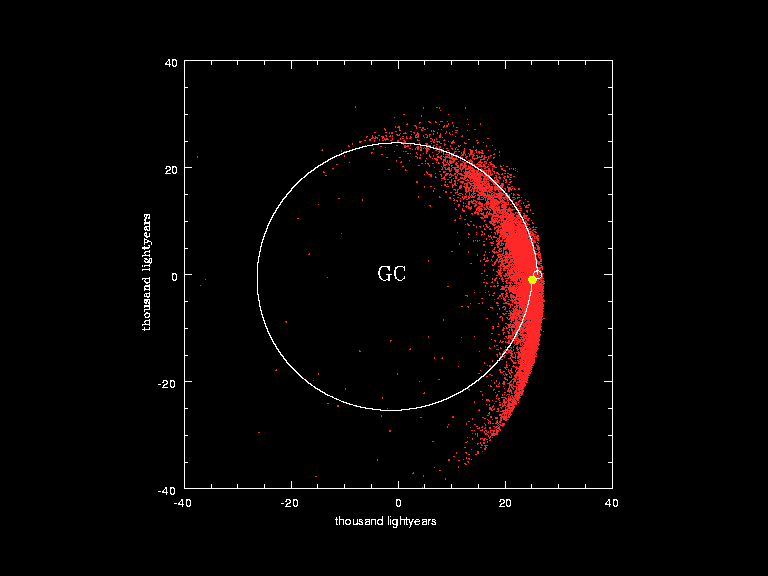Galactic year
The galactic year, also known as a cosmic year, is the duration of time required for the Sun to orbit once around the center of the Milky Way Galaxy.[1] Estimates of the duration of one orbit range from 225 to 250 million terrestrial years.[2] The Solar System is traveling at an average speed of 230 km/s (828,000 km/h) or 143 mi/s (514,000 mph) within its trajectory around the galactic center,[3] a speed at which an object could circumnavigate the Earth's equator in 2 minutes and 54 seconds; that speed corresponds to approximately 1/1300 of the speed of light.
The galactic year provides a conveniently usable unit for depicting cosmic and geological time periods together. By contrast, a "billion-year" scale does not allow for useful discrimination between geologic events, and a "million-year" scale requires some rather large numbers.[4].
Timeline of the universe and Earth's history in galactic years
The following list assumes that 1 galactic year is 225 million years.
| About 61.32 galactic years ago | Big Bang |
| About 54 galactic years ago | Birth of the Milky Way |
| 20.44 galactic years ago | Birth of the Sun |
| 17–18 galactic years ago | Oceans appear on Earth |
| 16.889 galactic years ago | Life begins on Earth |
| 15.555 galactic years ago | Prokaryotes appear |
| 12 galactic years ago | Bacteria appear |
| 10 galactic years ago | Stable continents appear |
| 6.8 galactic years ago | Multicellular organisms appear |
| 6.666 galactic years ago | Eukaryotes appear |
| 2.4 galactic years ago | Cambrian explosion occurs |
| 2 galactic years ago | The first brain structure appears in worms |
| 1.11 galactic year ago | Permian–Triassic extinction event |
| 0.2935 galactic years ago | Cretaceous–Paleogene extinction event |
| Present day | |
|---|---|
| 0.15 galactic year from now | Mean time between impacts of asteroidal bodies in the order of magnitude of the K/Pg impactor has elapsed.[5] |
| 1 galactic year from now | All the continents on Earth may fuse into a supercontinent. Three potential arrangements of this configuration have been dubbed Amasia, Novopangaea, and Pangaea Ultima.[6] |
| 2–3 galactic years from now | Tidal acceleration moves the Moon far enough from Earth that total solar eclipses are no longer possible |
| 4 galactic years from now | Carbon dioxide levels fall to the point at which C4 photosynthesis is no longer possible. Multicellular life dies out[7] |
| 15 galactic years from now | Surface conditions on Earth are comparable to those on Venus today |
| 22 galactic years from now | The Milky Way and Andromeda Galaxy begin to collide |
| 25 galactic years from now | Sun ejects a planetary nebula, leaving behind a white dwarf |
| 30 galactic years from now | The Milky Way and Andromeda complete their merger into a giant elliptical galaxy called Milkomeda or Milkdromeda [8] |
| 500 galactic years from now | The Universe's expansion causes all galaxies beyond the Milky Way's Local Group to disappear beyond the cosmic light horizon, removing them from the observable universe [9] |
| 2000 galactic years from now | Local Group of 47 galaxies[10] coalesces into a single large galaxy [11] |
References
- Cosmic Year Archived 2014-04-12 at the Wayback Machine, Fact Guru, University of Ottawa
- Leong, Stacy (2002). "Period of the Sun's Orbit around the Galaxy (Cosmic Year)". The Physics Factbook.
- http://starchild.gsfc.nasa.gov/docs/StarChild/questions/question18.html NASA – StarChild Question of the Month for February 2000
- Geologic Time Scale – as 18 galactic rotations
- Lunar and Planetary Institute (2010), https://www.lpi.usra.edu/features/chicxulub/
- Williams, Caroline; Nield, Ted (20 October 2007). "Pangaea, the comeback". New Scientist. Retrieved 2 January 2014.
- Franck, S.; Bounama, C.; Von Bloh, W. (November 2005). "Causes and timing of future biosphere extinction" (PDF). Biogeosciences Discussions 2 (6): 1665–1679. Bibcode: 2005BGD.....2.1665F. doi:10.5194/bgd-2-1665-2005. Retrieved 19 October 2011.
- Cox, J. T.; Loeb, Abraham (2007). "The Collision Between The Milky Way And Andromeda". Monthly Notices of the Royal Astronomical Society 386 (1): 461. arXiv:arXiv:0705.1170. Bibcode: 2008MNRAS.tmp..333C. doi:10.1111/j.1365-2966.2008.13048.x.
- Loeb, Abraham (2011). "Cosmology with Hypervelocity Stars". Harvard University.arXiv:1102.0007.
- "The Local Group of Galaxies". University of Arizona. Students for the Exploration and Development of Space. Retrieved 2 October 2009.
- Adams, Fred C.; Laughlin, Gregory (April 1997). "A dying universe: the long-term fate and evolution of astrophysical objects". Reviews of Modern Physics 69 (2): 337–372. arXiv:astro-ph/9701131. Bibcode: 1997RvMP...69..337A. doi:10.1103/RevModPhys.69.337.
- "Milky Way Past Was More Turbulent Than Previously Known". ESO News. European Southern Observatory. 2004-04-06.
After more than 1,000 nights of observations spread over 15 years, they have determined the spatial motions of more than 14,000 solar-like stars residing in the neighbourhood of the Sun.
- "Milky Way Past Was More Turbulent Than Previously Known". ESO News. European Southern Observatory. 2004-04-06.
After more than 1,000 nights of observations spread over 15 years, they have determined the spatial motions of more than 14,000 solar-like stars residing in the neighbourhood of the Sun.


